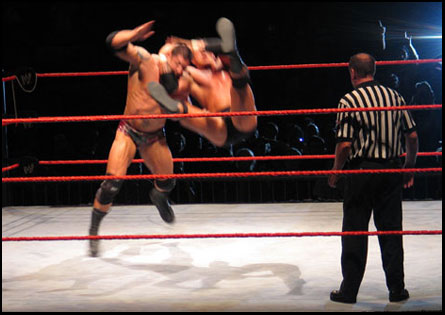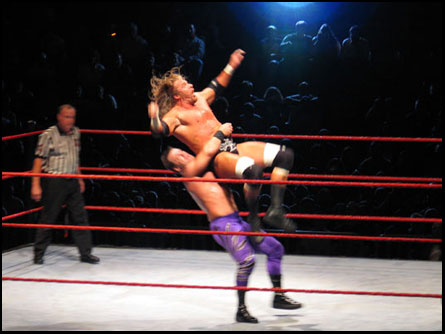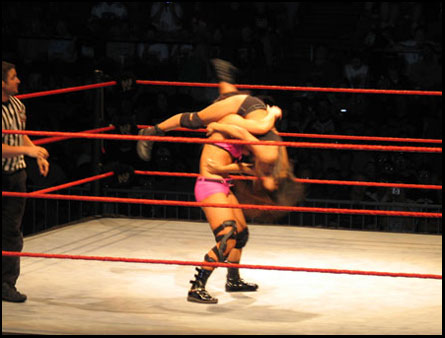What wrestling can teach us about our culture
[Here is the essay I mentioned a couple days ago. I have a couple of rejections and I don’t have the patience to wait for the rest. Enjoy!]
For more than two decades WrestleMania has lived hidden in plain sight behind the March Madness carnival and the start of the baseball season. Over 22 years pro wrestling’s greatest show (“the granddaddy of them all”) sold out the largest venues in the country – from the Silverdome to the Garden – and hosted its greatest bouts. World Wrestling Entertainment’s WrestleMania is what a political primary would be like if we weren’t watching every second of it on cable TV: blood, breasts and bodies being slammed through -tables, chairs or the ring mat.
On Sunday, close to 20,000 fans crowded the Allstate Arena outside Chicago for WrestleMania 22, a pay-per-view show the WWE said it sold out in two minutes last October.
There were druids, worms, a casket, lingerie, ladders, thrash cans, middle fingers and prayers. It was one of those Sunday nights when a man gets hammered with a bat wrapped in barbwire and then tackled off the ring apron onto – and of course through – a burning table.
That’s the uncompromising way the WWE writes its stories and America loves it. On Sunday a 165-pound heavy Rey Mysterio defeated two larger men to achieve his championship dream – an interesting narrative in the background of today’s immigration debate. The show closed with a match WWE wrote as prince vs. pauper contest – the Connecticut boy from riches Triple H taking on blue-collar-work ethic John Cena. And it was Cena that received the most boos.
Wrestling always had a lot to say about American culture, but judging from media coverage preceding the show, few out there are still listening. The Chicago papers printed unremarkable stories previewing the gala as did a few Southern papers, the only ones that cover wrestling as a beat. Today, the media is mostly ignorant when it comes to wrestling; ignorant to what the “fake sport” could say about the culture. The usual – if not natural – attitude towards pro-wrestling is disdain. On Sunday, The New York Times reviewed a book on pro-wrestling. The article was penned by a staffer who knows as much about wrestling as we know about the review assignment process. In a humble attempt to fill space Neil Genzlinger tried hard not to call fans idiots, rednecks and retards and showed restraint until the last graphs, where, desperate to show intellectual superiority, he envisioned a Times reader turning on WWE’s Friday Night SmackDown. He wrote:
“‘Gee,’ you may find yourself thinking. ‘there really is such a thing as unredeemable garbage after all. And this may be it.'”
The Times has once more enlightened readers by pointing out that SmackDown lacks the gravitas of, hmmm, a PBS documentary, or the cultural poignancy of the paper’s own Style section, which features much meatier trends and phenomena. I remember reading recently in the Times about what a woman’s rear-end should look like, about how dirty unkempt beards are still in and about a porn star bursting into the wine business.
The Times is certainly not alone in snubbing wrestling. After all there must be something wrong with people who like to watch grown men in Speedos fighting and rubbing against one another for minutes on end. There must be something wrong about cheering for a guy who eats worms, or lusting for breasts so big you wonder when they’ll pop and send the rest of the puppet flying through the crowd.
But if the idea is that beards can teach us something about America, than wrestling can too.
In the fall of 2004 I went to see a WWE house show in Columbia, MO (see pictures below). This wasn’t going to be on TV so the company went easy on the pyros. It was a subdued affair in the ring, with few risky moves and little to cheer for. At one point, Middle-Eastern music – more of a call to prayer – blared through the speakers and the crowd erupted on cue, heavily booing the two men walking down the aisle, even though they had never seen them before. The shorter man had a beard and was wearing a suit. The other man was bulkier, also had a beard and wore a white robe, complete with head covering. As they climbed into the ring, the bulkier man reached for the microphone. By then the “USA, USA” chants had caught on with almost everybody in the place.
In perfect English the man said his name was Muhammad Hassan. He was as Arab American who felt that after September 11 he had become an unfair victim of stereotypes and prejudice. The crowd could care less. Hassan stayed on message and said he wants Americans to respect Arabs and stop treating them like potential terrorists. It’s hard to tell if anyone was listening as “boos” kept pouring and they only intensified when the shorter man, Daivari, took the microphone and began speaking in what was to be understood as Arabic (it was Farsi).
I had never seen a WWE show live and was excited about the possibility of witnessing the company test a character before putting him on TV. The instant negative reaction of the crowd was stunning – I thought story lines and character traits took time to develop. But it appeared the WWE had long ago taught its fans that the villain will be easy to spot and, in a 9/11 world, all it took was the sound of a call to prayer.
Hassan made his television debut a couple months later and instantly became one of RAW’s most hated and controversial figures. The WWE had always walked a fine line in blending politics into its shows. During the Cold War it had a number of Russians wreaking havoc through the roster. Shortly after the Iran hostage crisis, it pushed the Iron Sheik. And now they had an Arab American and skits hinting at martyrdom and terrorism. Hassan continued drawing the ire of the crowds through July 2005, when, in the aftermath of the London bombings, his Arab gimmick became too sensitive for television.
Wrestling allows for a displacement of self – you can for or against any of the guys in the ring and you need no excuse for your actions and allegiances. You could hate or love everybody: the Arabs, the Canadians, the Mexicans, the hobo-looking brawlers and the perfect-body Adonises. Whatever you choose you’re guaranteed to go to bed happy because you watched a great show.
Sunday’s WrestleMania was the first one I ever watched in real-time. Pro-wrestling may have lost some of the glamour it had in the nineties but it can still put on a show and it can still ignite the crowds with contemporary and sometimes sensitive storylines.
If a sold-out arena in the Chicago area, hundreds of thousands of fans watching on PPV and a company that employs political master narratives isn’t a story about America and its culture, I must be in the wrong line of work and in need of being put through a burning table.



